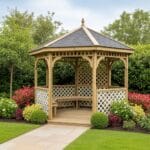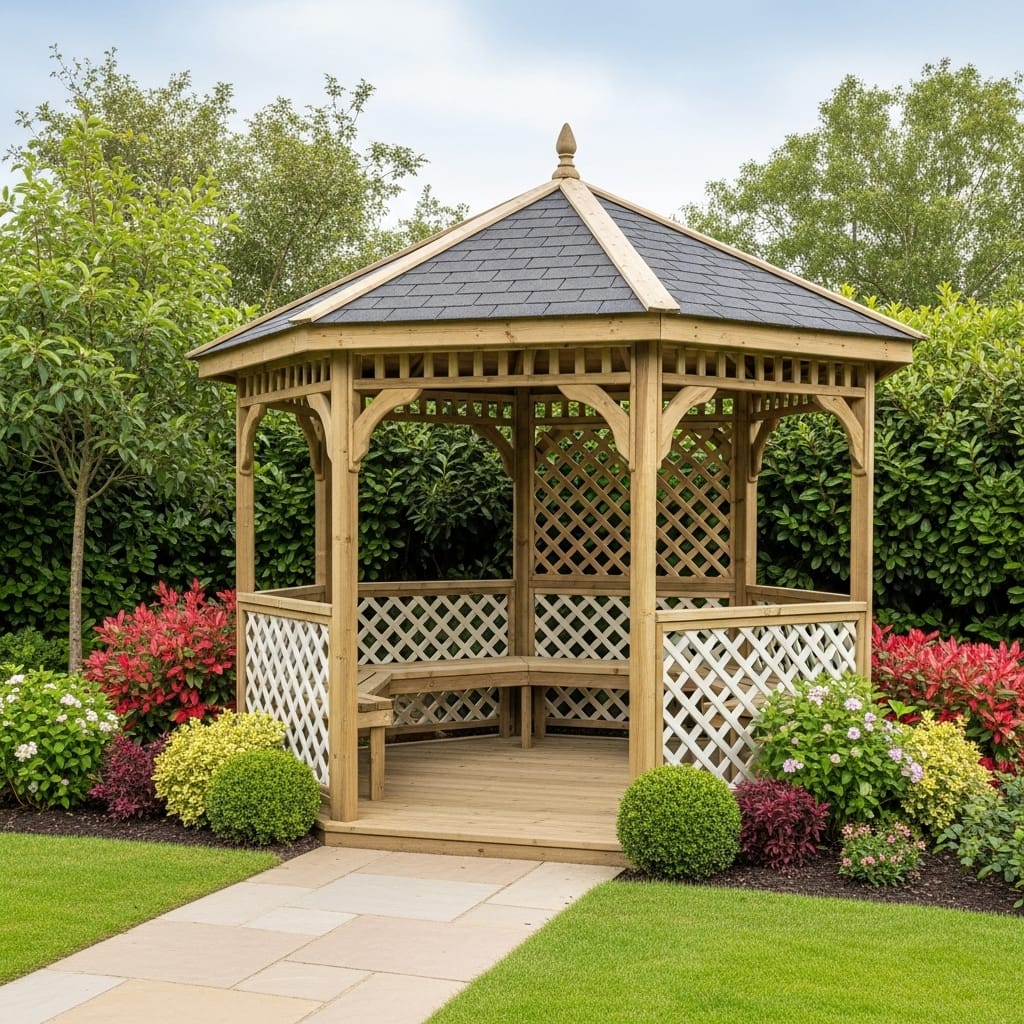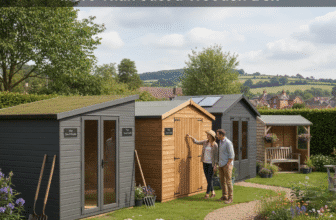
The Ultimate Guide to Finding the Perfect Gazebo for Sale in the UK
There’s a certain romance to the great British garden. It’s a space of changing seasons, of unpredictable weather, and of cherished moments spent outdoors. From the simple pleasure of a morning cuppa listening to the birds to the joyous laughter of a summer barbecue with friends and family, our gardens are an extension of our homes. Yet, how often are those plans scuppered by a sudden downpour or the relentless glare of a midday sun? This is where the humble gazebo transforms from a simple garden structure into the hero of your outdoor living space. It’s more than just a shelter; it’s a statement, a destination within your own garden, and a promise of enjoying the outdoors, whatever the weather decides to throw at you.
Finding the right gazebo for sale, however, can feel like a quest in itself. The market is awash with options, from grand, permanent wooden structures that evoke the elegance of a country estate, to sleek, modern metal designs and convenient pop-up shelters perfect for a party. This guide is here to navigate you through the choices, helping you find the perfect outdoor centrepiece that not only meets your practical needs but also beautifully complements your home and lifestyle. We’ll explore the materials, styles, practicalities, and the little finishing touches that will make your gazebo the most beloved ‘room’ of your house.
Why a Gazebo is the Perfect Addition to Your British Garden
Before we delve into the specifics of what to look for, let’s take a moment to appreciate why a gazebo is such a worthwhile investment for any UK home. At its core, a gazebo carves out a functional, sheltered area in your garden. It creates a defined space for dining, relaxing, or socialising, instantly making your garden more usable. Think of it as an outdoor living room or dining room, a place where you can set up comfortable furniture and leave it there, ready for whenever the mood takes you.

The most obvious benefit is, of course, the protection it offers. In a country famed for its ‘four seasons in one day’ climate, a sturdy gazebo provides reliable shelter from both rain and shine. A solid or waterproof roof means a sudden shower no longer sends everyone running for the back door. Equally, on those glorious, sun-drenched summer afternoons, it offers a cool, shaded retreat, protecting you and your loved ones from harmful UV rays. This simple function can dramatically increase the amount of time you spend enjoying your garden throughout the year.
Furthermore, a well-chosen gazebo adds significant aesthetic and financial value to your property. It acts as a stunning focal point, drawing the eye and adding a touch of architectural elegance to your landscape. Whether it’s a rustic wooden gazebo nestled amongst the flowers or a contemporary metal structure on a paved patio, it enhances the overall appeal of your outdoor space, making it more attractive to you now and to potential buyers in the future.
Choosing Your Perfect Gazebo: A Buyer’s Guide
The journey to finding the ideal gazebo begins with understanding the key variables. Your choice will depend on your budget, the size and style of your garden, and how you intend to use the space. Let’s break down the most important considerations.
Material Matters: Wood, Metal, or Fabric?
The material of your gazebo is arguably the most critical decision you’ll make. It dictates the structure’s appearance, its durability, the level of maintenance required, and its overall cost.
- Wooden Gazebos: There is an undeniable, timeless charm to a wooden gazebo. It blends seamlessly into a natural garden environment, offering a classic, rustic, or traditional look. Typically crafted from pressure-treated pine or cedar, wooden gazebos are robust and sturdy. Wood is also a natural insulator, meaning the space beneath can feel cooler in the sun and retain a little warmth on a chilly evening. The primary drawback is the maintenance. To protect the wood from the damp UK climate and prevent rot and insect damage, it will require regular treatment with a stain or sealant every few years. However, for many, this small effort is a price worth paying for the enduring beauty and natural feel of real wood.
- Metal Gazebos: For a more contemporary, low-maintenance option, metal gazebos are an excellent choice. Aluminium is a popular material as it’s lightweight, affordable, and naturally rustproof. Steel gazebos offer superior strength and wind resistance, making them a great permanent solution, though they are heavier and must have a powder-coated or galvanised finish to prevent rust. Metal frames allow for sleek, minimalist designs and can be paired with various roof types, from fabric canopies to hardtop polycarbonate panels. They require very little upkeep beyond an occasional wipe-down, making them a practical ‘fit and forget’ option for modern living.
- Pop-up & Fabric Gazebos: If you’re looking for a temporary, flexible, and budget-friendly solution, a pop-up gazebo is the answer. Perfect for parties, fetes, or occasional use, these structures consist of a concertina-style frame (usually steel or aluminium) and a fabric canopy. They can be erected in minutes and taken down just as quickly for storage. While incredibly convenient, they are not designed for permanent installation or to withstand strong winds and heavy rain. They are the ideal choice for renters or those who need an occasional shelter rather than a permanent garden feature.
Sizing Up Your Space and Purpose
Gazebos come in a vast range of sizes, from intimate 2.5m x 2.5m squares perfect for a bistro set, to expansive 4m x 6m rectangles capable of housing a full outdoor sofa suite and dining table. Before you start Browse, get out the tape measure. Mark out the potential footprint in your garden to get a real feel for how much space it will occupy. Consider not just the structure itself, but also the ‘breathing room’ around it. You don’t want it to feel cramped or to dominate the entire garden.
Think carefully about its primary purpose. Will it be a sanctuary for a hot tub, requiring good ventilation and privacy? Is it for alfresco dining, meaning it needs to comfortably accommodate your table and chairs with room to pull them out? Or is it a relaxation zone, destined for comfy outdoor sofas and a coffee table? Your intended use will directly influence the size and shape you need.
To Roof or Not to Roof: Hardtop vs. Soft-top
The roof is your gazebo’s primary line of defence against the elements.
- Soft-top (Fabric) Roofs: Common on pop-up and many metal-framed gazebos, fabric canopies are typically made from polyester with a PVC or polyurethane coating for water resistance. They are lightweight and often retractable or easily removable, offering flexibility. The main downside is their limited lifespan. Exposed to sun and rain, they will eventually fade, degrade, and may need replacing every few seasons. They also offer less protection against heavy, persistent rain.
- Hardtop Roofs: For a truly all-weather, year-round structure, a hardtop is essential. These are usually found on more permanent wooden and metal gazebos. Common materials include polycarbonate panels, which are lightweight, shatterproof, and UV-blocking, allowing natural light through while providing full shelter. Steel or aluminium panelled roofs offer maximum durability and a sleek, modern aesthetic. While the initial investment is higher, a hardtop gazebo provides a far more permanent and reliable shelter, transforming it into a true extension of your home that can be used in almost any weather.
The Practicalities: Planning Permission, Installation, and Budget
Once you have an idea of the type of gazebo you want, there are a few final hurdles to clear.
Do I Need Planning Permission for a Gazebo in the UK?
For most homeowners, the good news is that a gazebo will likely fall under ‘permitted development rights’, meaning you won’t need to apply for planning permission. However, there are important rules to follow. Generally, the structure must be for domestic use only and not be built forward of the principal elevation of your house. Height restrictions are key: if the gazebo is within two metres of a property boundary, it cannot be taller than 2.5 metres. If it’s further than two metres from the boundary, a dual-pitched roof can be up to 4 metres high, while other roof types are limited to 3 metres. These rules can vary, and if you live in a conservation area, a National Park, or a listed building, different regulations will apply. It is always a wise precaution to check your local council’s planning portal or give them a quick call to confirm before you buy.
Installation: DIY Dream or Professional Help?
The complexity of installation varies wildly. A pop-up gazebo is a ten-minute job for two people. A flat-packed metal gazebo with a fabric roof can typically be assembled by two competent DIYers in a few hours, armed with a good set of instructions and basic tools. Larger, more permanent structures, especially heavy wooden or hardtop gazebos, are a different matter. They often require a solid, level base (such as a patio slab or concrete pad) and the assembly can be complex and physically demanding. For these larger investments, it is often worth factoring in the cost of professional installation to ensure the structure is built safely, securely, and will stand the test of time.
Making It Your Own: Styling and Maintaining Your Gazebo
Your gazebo is built and standing proud. Now for the fun part: making it a beautiful and inviting space. Think of it as an empty room waiting for your personal touch. Outdoor furniture is the starting point, whether it’s a chic rattan sofa set or a classic wooden dining table. But the magic is in the accessories.
Drape weatherproof curtains or screens on the sides for a touch of privacy and a resort-like feel. Weave fairy lights or hang solar-powered lanterns from the frame to create a magical ambience as dusk falls. On cooler evenings, a freestanding patio heater or a cosy fire pit placed a safe distance away can extend its use well into the autumn. Add outdoor rugs for comfort underfoot and scatter cushions and throws for a splash of colour and luxury. Potted plants, climbers trained up the posts, and hanging baskets can help to soften the lines of the structure and integrate it beautifully into your garden.
Finally, a little ongoing care will keep your investment looking its best. For wooden gazebos, inspect the finish annually and re-stain or re-seal as needed. For metal frames, check for any scratches in the coating and touch them up with a suitable paint to prevent rust from taking hold. Soft-top canopies should be cleaned periodically with warm, soapy water and a soft brush, and stored dry over winter to prolong their life. A well-maintained gazebo is a joy for years to come, a steadfast sanctuary in your very own patch of the great British outdoors.







